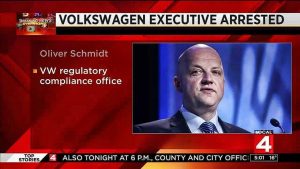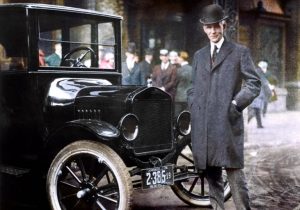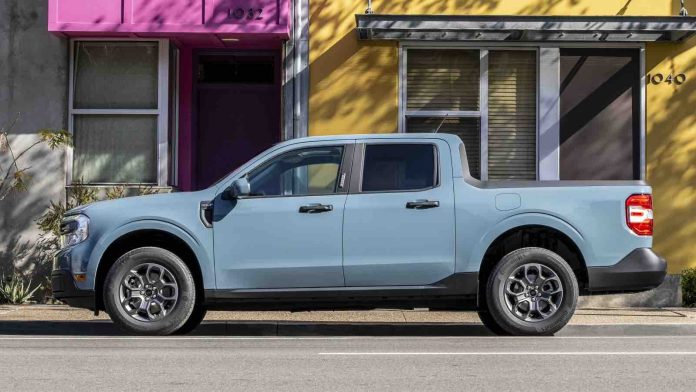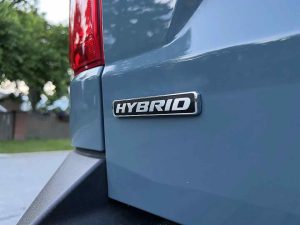Ford tries hard to sell the F-150 Lightning electric truck – but not many are buying. Probably because it is too expensive. Among other things.
Then there’s the Maverick.
This truck is such a hot seller Ford can’t keep up with demand. Probably because it’s so affordable.
When it came out in 2021 as a new-for-2022 model, it stickered for just under $20,000 to start – which is about a third as much to start as a new F-150 Lightning costs. Lots of people could afford a new Maverick – and lots of people wanted to buy one, too, because in addition to being affordable to buy it was (and is) also affordable to drive.
This compact-sized hybrid truck can travel more than 40 miles (in city driving) on a gallon of the gas that’s about twice as expensive to buy now than it was when Orange Man Bad. This makes it almost as economical as the diesel-powered small trucks you used to be able to buy in the Before Time but cannot in our times, as a consequence of the strangulating regulations issued by the same federal apparat that also says it’s necessary to “increase fuel efficiency.” In fact, the apparat uses the pretext of “fuel efficiency” to decrease the size of engines, with the end goal being to eliminate them altogether. By now, this ought to be clear to even the politically glaucomic. 
Back to the Maverick.
When Ford announced you could buy this 40 MPG-capable truck for just under $20k, people lined up around the block. They put real money down – as opposed to making a “reservation” to buy an electric vehicle like the Lighting. Many such “reservations” were cancelled as the people who made them developed reservations about actually buying a Lighnting on account of the truth about it (and EVs in general) getting past the propaganda about it.
The Lightning can pull a 10,000 pound trailer! Just not very far. The Maverick can go more than 500 miles on 14 gallons of gas – as opposed to 240 miles after 11 hours of charging. Like the compact-sized trucks that were once made by every major vehicle manufacturer – and some of the minor ones, too – the Maverick was both useful and affordable.
The kind of truck lots of people can use – and can afford. And therefore, want.
And no one else makes such a truck. The others all sell mid-sized (and larger) trucks, many of which people also want but which fewer can afford because they all cost a lot more than less-than-$20k-to-start.
And now so does the Maverick.
Ford just announced its base price will no longer be just under $20k but just shy of $25k – but it’s actually just shy of $27k. The reason why is that the 40-miles-per-gallon hybrid drivetrain that was standard when the Maverick came out last year will be a $1,500 option henceforth. The ’24 Maverick will comes standard with the previously optional 2.0 liter turbocharged engine that does not deliver 40-miles-per-gallon.
It delivers 28 miles-per-gallon. That’s on the highway. In the city, it delivers 22 miles-per-gallon. The hybrid Maverick goes 33 on the highway (and averages 37 because it gets 40 in the city). 
The nut of it is that you’ll henceforth either pay about $7k more to get the version that gets 40 MPG or you’ll pay $1,500 less than that to get about ten miles-per-gallon less.
Why would Ford do this?
Fewer people will be able to afford the upsell – and fewer people are likely to want a Maverick now that its former chief merits no longer are. If you’re going to spend not-far-from $30k on a truck, it’s not that far a jump to a larger – and more capable – truck. In fact, you can buy a Ranger – Ford’s mid-sized truck – for about the same (its base price is $27,400) and unlike the Maverick, which is a lighter-duty vehicle built on a passenger-car-like FWD layout (AWD is optional) the Ranger is a real truck, with available 4WD and Low range gearing and so more capable and rugged than the Maverick.
Why spend the same to get less?
Doubtless, many Maverick-inclined buyers will be asking themselves that very question. But why would Ford undermine the Maverick, which sells better – by far – than the Ranger?
Last year, Ford sold 74,370 Mavericks vs. 56,987 Rangers – and probably could have sold more Mavericks if it had been able to build more of them. Instead, it spent a great deal of effort building – and marketing – Lightnings, which Ford sold about 15,000 of in 2022.
Maybe that explains it.
Maybe a Maverick that sells for less than $20k that gets 40 MPG and goes 500-plus miles on 14 gallons of gas is too striking a contrast to the truck Ford wants to sell that costs $60k (almost) and goes 240 miles (maybe) after it’s been plugged into your house for about 11 hours.
Kind of like the 50-MPG plus, 600 miles-of-range (and $22k-ish-to-start) diesel-powered VWs that were conveniently found to be “cheating” back in 2016 – just in time for the $50k-plus EV juggernaut to get going. 
Some will say Ford was losing money on the under-$20k Maverick hybrid and so had to increase what it costs to buy one in order to not lose money selling them. But Ford is losing much more money on the almost-$60k Lightning and its other EVs, to the expected tune of some $3 billion dollars, as recently admitted to by Ford CEO Jim Farley.
Demand for the Maverick could make it very profitable to sell at $20k. All Ford would have to do, probably, to make it happen would be to sell more of them. Volume would make up for lower (per vehicles) profit margins.
But there will never be enough demand to make the almost-$60k-to-start Lightning profitable because there just aren’t that many people who can afford to buy an almost-$60k-to-start anything. That figure is approximately the equivalent of the average American family’s entire annual pre-tax income. This begs some interesting questions about the purpose of making vehicles that average Americans cannot afford to buy – while raising the price of those they can afford to buy.
. . .
f you like what you’ve found here please consider supporting EPautos.
We depend on you to keep the wheels turning!
Our donate button is here.
If you prefer not to use PayPal, our mailing address is:
EPautos
721 Hummingbird Lane SE
Copper Hill, VA 24079
PS: Get an EPautos magnet or sticker or coaster in return for a $20 or more one-time donation or a $10 or more monthly recurring donation. (Please be sure to tell us you want a magnet or sticker or coaster – and also, provide an address, so we know where to mail the thing!)
My eBook about car buying (new and used) is also available for your favorite price – free! Click here. If that fails, email me at EPeters952@yahoo.com and I will send you a copy directly!














Ford CEO “We’re Losing Billions and Can’t Sell Cars”
https://www.youtube.com/watch?v=WjQk3Mmy-oY
“This makes it almost as economical as the diesel-powered small trucks you used to be able to buy in the Before Time”
30+ years ago?
Bought a 3/4 diesel pickup for the kid to use that he customized thinking he would keep it but once diesel went over $5/gallon he decided it wasn’t worth it.
COVID craziness meant I was able to sell it for what I paid, thankfully.
Mahindra came close to getting the USA a small diesel pickup but that fell through over a dispute with the dealer network.
What happens if you crash an EV? No idea, says car industry.
https://www.youtube.com/watch?v=CYzsW4SgxbI
Why aren’t they crashing these things into walls like they do with every other vehicle and assessing the results?
Eventually EV’s are going to smash into each other and spray lithium, cobalt, manganese, graphite, nickel, and whatever else they find to make these batteries with, all over the road and hapless people.
Not only are they going to be a hazard when they shatter, catch fire, and break down, but eventually they will be dumped in piles in various locations the same as old cars and tires are. But with old cars the oil is virtually harmless and the gas evaporates. With batteries those toxic chemicals are going to leech into the ground and continue the poisoning of our environment.
You would think this would make an impression on the so-called environmentalists that are driving this madness but since they are passionate believers in the mantra of “climate change” they chose to ignore it.
EVs are crashed for safety testing just like ICEs
The results are about the same — the vehicle totaled. The real risk is any on the road crash that damages the battery case, which could also total the vehicle. That will affect EV insurance costs. I doubt if there would be many battery case repairs.
Richard writes:
“That will affect EV insurance costs.”
It will affect all our insurance costs – as the goddamned mafia will increase everyone’s costs, to “cover” the cost of EVs. Just the same as we’re all paying more now to “cover” the cost of half a dozen air bags in every new car.
Richard, ‘What would the insurance company think?’ Greene.
I have a step sibling who looks at things through that lens and it is absolutely pathetic. Stop worrying about following all the rules. The ones enforcing them don’t.
Car industry says private car buyers ARE NOT BUYING EVs…!
https://www.youtube.com/watch?v=PZMUUV9GrUs&pp=ygUSbnVtYmVyIDI3IG1rIDMgZ3Rp
The sad reality is that on the dealer lots the Rangers are around $40K
My guess is the price and equipment re-arrangements have to do with how people/dealers were ordering them and the usual “market adjustments” at the dealers since the last thing Ford does in the last many years is find a way to meet demand.
Then again the car business isn’t free market anymore and I live in the vestiges of a free market so in my work it’s always finding ways to build to meet demand.
EV madness has arrived. One ship full of new cars was scuttled in the middle of the Atlantic somewhere about a year ago now. Another ship in the Pacific caught fire when a fire broke out from an EV on the ship. Had to have a rescue, if memory serves me right.
None of it is going to work for transportation needs, ain’t gonna happen. Phones and computers, go for it. EV fanatics will eventually give it up. The demand will wither and die on the vine, there they were, gone.
Supply and Demand rules the game.
What will happen. More lithium for the crazies in the WEF where it is needed in the worst way.
If there are no ICE cars, gas will cost nothing, won’t do any good to have gasoline, no car for you.
When I worked as an employee at a workshop for mentally and physically handicapped people, lithium was a daily dose for a number of them.
Some people do need to be psychologically managed with pharmaceuticals, otherwise they will go haywire. The Colorado Joker who opened fire in a theater was being prescribed psychoactive substances, probably Prozac. All of the psychologists involved say ‘it wasn’t me’ and then go into denial.
It all leads to King Crimson’s 21st Century Schizoid Man, Hunter is the poster madman.
And everyone is supposed to listen to Joe and anybody else who thinks they can tell people what to do. You have to tell them where to go, not a hard thing to do.
1 000 000 000²= 1 000 000 000 000 000 000 or one quintillion, really, that is the number when you square one billion.
You’re looking at one billion billion.
Also the number of weeds for every 10 hectares of land and the number of herring, cod, halibut, red snapper, tuna, shrimp, crab, lobster and every living creature in all of the seas. 130 billion mammals are living and dying on earth, nowhere else to be or go.
All on one planet, abundance is everywhere you go.
The idiot elites want you to think there is nothing for you and that is the WEF’s plan, for you to have nothing. The idiots who think they are running the show need heavy doses of lithium. Truckloads of the stuff. Al and Klaus and Bill are on a flight over the cuckoo’s nest. You know how cuckoo Yuri is, nothing stopping these crazy nuts.
When everything around you shows no scarcity whatsoever, you still will have hell to pay say the frauds in charge.
Thousands and thousands of square miles of forest, grass biomes that stretch from the Gulf of Mexico to Alberta and beyond.
Vast stretches of Eurasia is an extortionist’s dream, a swindle that will pay for eons.
Just too good to be true, can’t be beat. Doubtful it will work, might have to fight for it, Russia the Bear won’t take it lying down.
None of it is for you, WEF suckers!
I had to read this article twice because of so much cognitive dissonance. Popular vehicle is bad because it is affordable and fills a customer need. Unpopular vehicle doesn’t sell well and needs more goosing while the market develops. Answer: submarine the popular vehicle, blame “transitory” inflation. This cannot last.
Unfortunately I’ve become addicted to YouTube Shorts. Hopefully it’s just a summertime fling, not a chronic problem. One thread this week has been congressmen grilling DOT officials about EVs. Lauren Boebert was one of the inquisitors. While I admire the effort, clearly she was reading a script and had no idea what she was saying. Perhaps it was a set-up to make her look bad (the Republicans have written off Colorado as the next California, so she’s probably going to lose her district), or maybe she really is that stupid and they see her as a liability. But her performance aside, the point was pretty obvious that no one had any answers. If the legislators and regulators don’t understand the markets they are regulating, they have no business regulating anything. Now someone would say that the cabinet members shouldn’t need to know the details… I call bullshit. The cabinet is structured like the divisions of a corporation (or vice versa), and if I were a CEO I’d sure as shit hire people who sweat the details and can recall them chapter and verse. What the hell are we paying them for? They have at most 8 years to change the world, and they’re sitting around snorting coke and playing dress up. If that was all they did I’d be OK with that. At least they’d leave us alone. But they have to meddle in things they don’t understand under the guise of revolution. Better have some iodine tablets and water filters handy, you’re probably going to need them…
“Brownie, you’re doing a heckuva job.”
BTW, “Brownie” is developing a talk radio show which the big San Antonio Clear Channel station currently airs late on Sunday afternoon. Whoever really pulls the strings has Brown imitating Rush Limbaugh very accurately.
As long as the feds keep interfering and subsidizing the auto industry, Ford and others will continue to run contrary to market forces. The medical, pharm. & health insurance industries are prime examples of government screwing things up!
Amen, brother!
Hi Allen,
I’m sure just like everything Fedzilla touches, the losing money part isn’t important. They’ve convinced themselves they’ll make it up on volume.
I was seriously considering placing an order for a 24 Maverick until I heard about the price increase. I can see maybe a $500 increase, but the XLT is going up $1500 and if you add the $1500 premium for the hybrid, an XLT hybrid is up 3k. That’s one way to reduce demand. I drove a couple that were available at local dealers recently. I liked both of them enough to want to order one and don’t need or want a real pickup. A Lariat hybrid was marked up 10k and an XLT Ecoboost was marked up 7k. Of course I didn’t tell them I wouldn’t pay the markup until after I drove them 🙂
Exactly – the only Mavericks my local country dealer has on the lot are loaded up versions costing almost 40k – there are no entry level or hybrid models, and you can’t even order one.
When you actually look at one of these in person you see how small they are – a bargain at 25 to 30k – a foolish purchase in the high end version.
Ok, so is the author claiming (rather passive aggressively, which possibly outs her as a female, posing as a male) that Volkswagen did NOT falsify emissions test results? If so, please write that article, ma’am. If supported by evidence, that would be worth reading, as opposed to: “Carmaker charges too much for its crap-mobiles, boohoo!”
Whoa, easy big fella. Eric has written many articles on the VW emissions “scandal.” Just search his site for them (there’s a search function at the top right of this webpage).
Just like every other manufacturer that sold small diesels, VW programmed the ECM to pass the test. They just happened to get “caught” first. As Liberty points out, many pixels have been generated by Eric writing about it.
But you’re missing the point. What might have been with TDIs, actually using less fuel and therefore by definition generating less CO₂, doesn’t fit the goals of the EV pushers.
They were not charged with falsifying emission test results. They were charged with being smart enough to program their vehicles to PASS the test. Come back when you grow up.
Tom,
What VW did was program its vehicles to pass the test. This was characterized as “cheating.” The “cheating” in question involved literally fractional differences in NOx emissions. There was no evidence produced that this harmed anyone; it was simply a question of affronting the authority of the government. And that is why there was such “outrage.” In addition, something had to be done about those very affordable, highly efficient TDI VWs as their availability made EVs look even dumber – functionally and economically – than they do now. What person in his right mind would buy a $35,0000 EV with a maybe 200-ish mile range that takes at least 30-45 minutes to partially recharge when he could spend $24k on a TDI Jetta that goes 600-plus miles on a tank and takes five minutes or less to refuel?
As regards the rest: Why do people like you always resort to infantile personal attacks? I supposes it’s because you haven’t got( or understand) the facts. And – for the record – at 6 ft 3 and 225, I’d make a damned unconvincing woman.
Too tall and not fat enough to be a transitioned “woman”.
“I’d make a damned unconvincing woman.”
Well, if “Admiral” “Rachael” Levine is a “woman,” Eric would probably be a Cosmo cover model by comparison…
Hi X,
I have given serious thought to “identifying” as old enough to collect Socialist Insecurity. Why not? If a guy can “identify” as a woman and by dint of so “identifying” steal scholarships and awards from women, why can’t I at least get back some of the money that’s been stolen from me?
Sound like a Bot or a lover of tyrannical gov. mmmm kissy kiss.
Haha! TomS says author is passive-aggressive then passive-aggressively calls him a pussy by insinuating he writes like a woman.
Hey if EP was a woman he would be one mean ol’ greasy diesel dyke!
Thanks, Cashy!
I’d do my best to emulate this: https://www.youtube.com/watch?v=5D0o2sLsGAk
A hybrid is an EV. The battery goes out on them too. Do not be deceived. I owned one of the first hybrid Honda Civics. The battery went out, fortunately, before the warranty expired. After replacement I sold it….lucky to get rid of it.
My early Civic Hybrid experience was the C/V transmission started to get cranky @ 17k miles, sold it w/great effort, to a used car dealer, he deserved it.
Phord is in deep financial peril by the way, maximizing profit in anything they can find is probably a sound business decision.
Yeah,,, I don’t comprehend it either. The Li on pack lasts about 8-10 years. $8000 for a replacement IF they are available. Try selling it is 7-8 years with an ageing battery pack. Present warranty is 8 years or 100,000 miles. Your gonna get zip unless the buyer is willing to drive it without the battery,,, if that is possible.
Why not a 40mpg diesel,,, just because govmafia says NO! Who in hell are these jerks?
Where in the constitution is the authority for govmafia to tell a citizen what he/she can or cannot have,,, do,,,or go?
How long are we going to put up with govmafia’s lockdowns, patdowns, killer vaxxes, 15min cities, no cars by 2050, airports shutting down, eating bugs, living in sheds, etc?
The Constitution does not provide for its own enforcement. The States had that authority, by means of secession, until Lincoln killed about 650,000 Americans to dispose of that notion. More killed than in all other wars combined.
The SCOTUS usurped that authority, since it is not given to it in the document.
I actually wonder how long the battery pack is going to last on plug-in and mild hybrids. My wife owns a Toyota Yaris (mild hybrid). It is 10 years old and it has run 140 000 kilometers (close to 100 000 miles). The battery pack still seems to be in an acceptable working order, but I still wonder for how long it is going to last and how much it is going to cost to replace it
I have already warned my wife that the battery pack might soon have to be replaced. The good news seems to be that it is physically easy to replace the battery, since it is placed just below the rear seat. The bad news might be that the battery is electronically married to the car, and that a Toyota shop needs to assign a new battery electronically to the car, before it will work.
Hi Jone,
The battery in your wife’s hybrid Yaris will eventually need to be replaced. But hybrids batteries last much longer than full-EV batteries, because they are part-time batteries. The engine powers the car most of the time. And the engine is used to (as a generator) assure that the battery is never heavily discharged, which helps to increase the battery’s service life.
When the time does arrive to replace it, the cost will also be worth the expense – because the hybrid’s battery costs a fraction of what an EV’s battery pack does. Because it is a much smaller battery.
Didn’t Ford recently receive a $9 billion bailout -er- loan from the Federal Government to build the EV battery plants for their “T3” project?
T3. Trust The Truck.
Of course, the 80s nerd in me thinks “Terminator”. And “Tommy Boy” whenever I see Farley speaking in a video clip.
Roscoe,
Yes, Ford did get billions of taxpayer dollars from the Biden regime for its EV business. And what does Ford do shortly afterward? Lay off at least 100 employees.
My brother put over 500K miles on a 90s era Ranger. It was a tough little beast. And with its 5 speed manual tranny (the good kind of tranny, not the other) it got excellent gas mileage.
Like Archie & Edith sang, those were the days.
Isn’t it possible that they are raising prices on the vehicles that do sell well in order to cover some of their losses on the EVs? I suspect that automakers across the board are going to do something similar.
“OK, you don’t want the fucken EV? Then you’re gonna subsidize their sales anyway!”
I mean, I don’t know but it sounds likely because the people running those corporations are clearly out of their fucken ideological zealot minds. They’re gonna everything and anything to avoid reality until they are forced into rehab.
I’ve been around clinically psychotic before.
Hi XM,
I think so, yes. Indeed, I think they have to. EVs are a cash bleed. Ford admits they will cost the corporation at least $3 billion. This is not – what’s the word? – sustainable. So, someone – that’s us – will be expected to “sustain” it.
No one at auto companies raises prices of one vehicle to subsidize sales of another vehicle. All price increases have consequences — lower sales. Sometimes the product planners will find a vehicle is much more popular than initially expected. They then calculate that company profits would remain the same, or even increase, at a higher sales price. The more popular vehicles get price hikes if those price hikes are not likely to affect the net profits of that car or truck line.
An auto company can’t bail out money losing products by raising the prices of popular products. If that was possible, auto makers would be like money making machines with high profit margins. Ford had a 1.75% profit margin in 2022 — that’s far from a money making machine.
There can be other reasons for a price hike:
(1) Another assembly line would be required for the anticipated demand, and no space is available,
and/or
(2) Actual sales are too high relative to the sales volumes assumed when investing in production tooling, mainly for sheet metal dies. If it looks like an unexpected high sales volume would require another set of expensive production tooling in the future, the vehicle price can be raised to limit sales.
Part of the Ford losses on EVs are from investments in engineering for future EVs, not yet on sale, and investments in battery plants, not yet completed. The other cause is very poor sales of existing EVs.
They may not be directly related to subsidizing other product, but they do none the less. It’s all one company. If one product is losing money and another is making money, then by design or not, the latter is subsidizing the former. Raising prices on the latter is just a stupid sales model. Or in this case, could easily be intentional. If they were smart, they wouldn’t be bothering with EV pickups. At such a high price and with such low demand, that’s a job for the custom shop.
The marketplace competition determines the MSRP. Ford’s ICE pickup trucks and large SUVs have always provided the large majority of net profits from vehicle sales. Ford can not raise the prices of those popular products with no consequences, in an effort to bail out other less profitable or loss making products. That was my only point.
” If they (Ford) were smart, they wouldn’t be bothering with EV pickups.”
Ford can’t be smart:
A 2023 base F-150 Lightning Pro now starts at $59,974 — a $20,000 higher than the original advertised 2022 price of $40,000.
In 2022, Ford sold 15,617 F-150 Lightnings. In December 2022 the total was 4,775. Multiply 4,775 by 12 and you’re at an annual total of 57,300 for 2023.
How are actual Lightning sales in 2023?
First-quarter sales for the THREE months totaled about 4,300 units, about 10% less than the ONE month of December 2022.
That’s a disaster, but ought to have been expected, following multiple price hikes that totaled +50% since the original 2022 price of $40,000.
The Lightening EV could be a good business school case study, like the Edsel flop.
Richard,
I would be willing to bet that Ford has already exhausted much of the potential buyer pool for the Lightning. Those who wanted one, bought one. This is not a recipe for growth.
Indeed, there are only so many urban cowboy goat ropers with adequacy issues, 6 figure incomes and a need to virtue signal. All these EVs are candidates for custom shops.
People are cancelling F150 Lightening orders mainly due to repeated price hikes.
https://12ft.io/proxy?q=https%3A%2F%2Fwww.westernjournal.com%2Fnews-fords-f-150-lightning-causing-customers-cancel-orders%2F
That’s your opinion, Richard – and maybe you’re right. It is my opinion that there are only so many people who have any interest in electric trucks. I say this as someone who knows a lot of “truck” people – by which I mean people who use trucks for work and to do things, not just carry kids to soccer practice. None of them have any interest in one of these functionally compromised and overpriced EVs.
Hi Richard,
The automobile market is making it harder to buy an ICE vehicle. They are increasing the price to change public opinion or to make it impossible for many to afford a new one.
I have a client that has been shopping for new SUVs for their company for months now. It seems most of the larger SUVs are on backorder. They also come with a premium. A new Suburban will set someone back $90K now…if you can find one. Want a Porsche Carrera Cabriolet? It is a three year wait.
The market is being changed before our eyes and it smells like government interference.
Hi RG,
Yup. It’s a measure of the madness that a Tahoe – a Tahoe! – sells for $50k-plus on the low end. It’s a nice vehicle – but it’s just a body-on-frame/truck-based SUV with a V8. Basically, a simple vehicle. The kind of vehicle most Americans used to routinely drive that sold for a lot less than $50k-plus.
To make the point: In 2011, you could buy a new Ford Crown Victoria for about $30k. That is about $41k today. The Vic was a lot like the Tahoe is, fundamentally. Rear-drive, body-on-frame and V8 engine. Full-size. Seated six. And it cost abou $12-15k less in inflated adjusted dollars than a new Tahoe.
Hi RG
There could be no logical reason for increasing ICE vehicle prices except when doing so will increase, or not change, net profits, do ue to strong demand. There is no reason to raise ICE vehicle prices and reduce sales now. There may a reason in 2026 when the 49mpg CAFE regulation take effect.
I buy Toyota Camrys — cheap and very reliable. The old Crown Victoria and Lincoln Town Car were the only profitable car lines when I worked at Ford from 1977 to 2005. But the ICE F-Series was always the big moneymaker.
Hi Richard,
Businesses will take a dip in overall quantity if they can get consumers to spend more to make up for buying less.
An example, the Chevy Suburban:
In 2017, 56,516 Suburbans were sold. The average market price was $47,244. This equates to $2,670,041,904 in revenue.
In 2022, 50,951 Suburbans were sold. The average market price was $60,246. This equates to $3,069,593,946 in revenue.
General Motors sold 5565 less cars, but made $399,552,042 more in sales.
That sounds like a great business model – work less, but make more!
Can this hurt a business? Yes. Eventually there will be a price point that will cost them sales, but as of today, it hasn’t arrived yet.
FYI: January to June 2023 the Suburban has sold 30,594 units. If that trend continues the Chevy Suburban will sell approximately 61K units this year. The average price for 2023 – $72,195.
Should be selling less….
But 2.67 billion in July 2017 dollars has the same purchasing power as 3.23 billion in July 2022 dollars, so GM did not gain.
Actually, they did gain. The cumulative inflation rate between 2017 to 2022 was 19.13%. The same vehicle purchase in 2017 for $47,244 would be $56,281 in 2022.
$56281 x 50,951 = $2,867,573,231. Their sales still increased $202,020,715 over the rate of inflation for selling less cars.
The Bureau of labor Statistics says the consumer price inflation rate from July 2017 to July 2022 was 21%, not 19%.
Richard,
What idiot would trust anything purveyed by a government bureau? The fact is the entirety of the federal government is rotten to the core and nothing it says or does can be – should be – taken at face value as remotely accurate or true.
Fox body Mustangs didn’t make money? I call BS.
All the carlines except Lincoln Town Car, Mercury Marquis and Ford Crown Victoria were marginally profitable when using fully accounted costs, which includes warranty expenses. Far from the net profits from pickup trucks, large SUVs and those three car lines.
Mustangs were very profitable in the 960s when volume was huge.
Only 129, 858 in 2004, the last year I worked at Ford. I had a bean counter finance friend who showed m the profits split by car and truck lines every year. Ford would have been a low profit company without the F150 profits, when they sold 939,511 in 2004.
You haven’t backed up you claim that the Fox body Mustang was a money loser.
‘By now, this ought to be clear to even the politically glaucomic.’ — eric
Excellent! We’re the politically glaucomic, ruled by the administratively malignant, doing the bidding of the ethically depraved.
Meanwhile, here’s what Ford told Maverick Hybrid buyers:
‘Unfortunately, battery availability continues to be an issue for Maverick orders with the 2.5L Hybrid engine.
‘We would love to tell you how this will impact the order process for the 2024 Maverick, but we’re still working through the details.’
https://tinyurl.com/33rmtpy9
Great — have a heaping helping of weak bullshit for breakfast! Who wrote this evasive malarkey, Alissa Heinerscheid?
Under the back seat of the Maverick Hybrid is mounted a high-voltage, liquid-cooled Li-ion battery, of about 1.1 kWh capacity. It’s like a baby brother to the 57 or 75 kWh battery in a Tesla Model 3.
Millions of square feet of fedgov-subsidized, white-elephant EeeVee battery plants are under construction. But Ford can’t source a chickenshit little 1.1 kWh Li-ion battery pack to complete 2023 Maverick Hybrid orders?
Pathetic. Jim Farley, I’m gonna have to fire your ass …
A shortage of batteries would be a good excuse for a price hike.
Another reason could be dealers selling Mavericks at above the MSRP. When Ford sees that, which is rare, they tend to increase their wholesale price to the dealers.
Hey Jim,
“But Ford can’t source a chickenshit little 1.1 kWh Li-ion battery pack to complete 2023 Maverick Hybrid orders?”
The obvious answer would be to convert Lightning production capacity to Maverick production capacity. While that might take some doing, it would be the sensible thing.
Also, I could see a little supply-and-demand price increase, but this look like Ford is trying to murder their Maverick sales in favor of the the abortion they are FORCED to produce.
I think I’ll wait for the Toyota Stout. I found the Maverick very appealing for my needs at this point in my life, especially at the original price. I do have concerns about Ford quality, and since you couldn’t get a Maverick at anywhere near sticker, if at all, it’s off my list for consideration. If Toyota brings out the Stout sometime next year, I’m confident it’ll be superior to the Ford in every way.
“Please don’t distract us from making a vehicle few can afford and even fewer want. We just raised the price on the one that many could afford, and even more wanted so we could keep up with demand without investing in more capacity, which investment we used to increase capacity for the one that is not in much demand.”